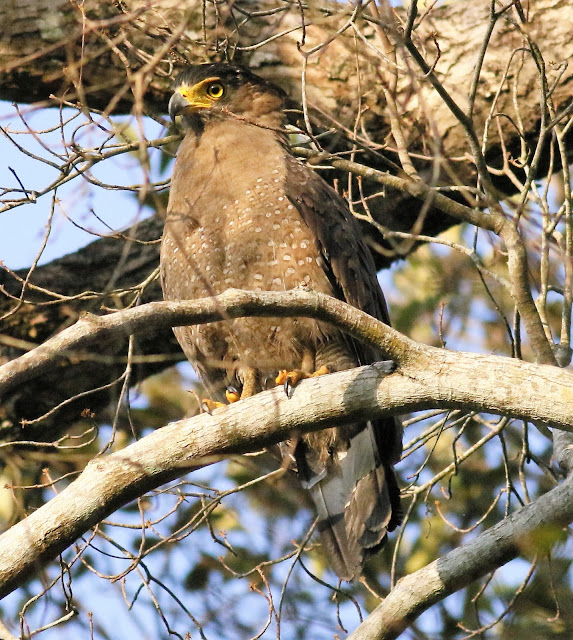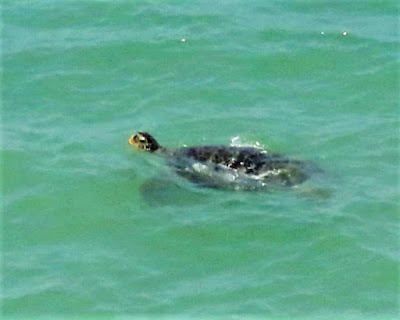The jungles in Peninsular Malaysia have so much to offer that i believe Sir David F. Attenborough would have felt like a young man again if he ever foraged into one over here. While the migrant birds have left the shores of Peninsular Malaysia, the local birds are having a ball of a time. I tried to catch a glimpse of Ms Ruddy the Kingfisher but she was already long gone when i reached the place. The other residents nevertheless took over the show.
 |
| Crested Serpent Eagle (Spilornis cheela malayensis) |
Ever wonder how did this CSE got into those maze of twisted vines and twigs? Actually it first perched on a bare trunk slightly to his right. As he noticed that i was watching him, he had slowly tip-toed into those vines and twigs so that he could be 'hidden' from my view. Ha ! you could never hide from this ol' man. After awhile he got fed-up and flew away to another tree.
Not long after he departed, i saw him again ! This time just look at what has he got? (see photo below)
Once awhile you will get this sort of stunning and priceless photo. It had already beheaded the snake when i saw him. This is a photo showing a hunter living fullest to its namesake. Due to its headless state, experts have had some difficulty in identifying the snake but they reckoned that the snake could either be a Ptyas carinata (Keeled Rat Snake) or a Xenochrophis flavipunctatus (Yellow-Spotted Keelback Water Snake). As the saying goes: "whatever you do, just don't lose your cool and head" !
 |
| Crested Serpent Eagle with Prey |
A Stamp of Authority !
Once awhile you will get this sort of stunning and priceless photo. It had already beheaded the snake when i saw him. This is a photo showing a hunter living fullest to its namesake. Due to its headless state, experts have had some difficulty in identifying the snake but they reckoned that the snake could either be a Ptyas carinata (Keeled Rat Snake) or a Xenochrophis flavipunctatus (Yellow-Spotted Keelback Water Snake). As the saying goes: "whatever you do, just don't lose your cool and head" !
 |
| Malacocincla abbotti abbotti |
His only weakness is that he likes to sing and at times he is loud which often reveals its position.
Ini burung hijrah ke?
Ya ! ini burung hijrah. Mereka hijrah dari Seberang Jaya ke Kepala Batas setiap hari !
I wish i have those mesmerising eyes !
Ya ! ini burung hijrah. Mereka hijrah dari Seberang Jaya ke Kepala Batas setiap hari !
I wish i have those mesmerising eyes !
I have noted that this place has recorded "Tinkle Bell's" Flycatcher before so could this be it?
This one is certainly a Mangrove Blue Flycatcher !
How about this one? Could this be a Slaty-Backed Flycatcher?

Maybe but whatever your guesses are, i believe this flycatcher was just a Mangrove Blue Flycatcher as well ! (note: its longer bill and body size)
Wonder what was it looking at?
Could it be this gigantic Purple Heron?
Nope! its even bigger than the above bird (see photo below)
It flew so low that you can see its markings and serial numbers.
Perhaps it was sending lots of "kimchi" to Penang island people !
HAPPY BIRDING !
This one is certainly a Mangrove Blue Flycatcher !

Maybe but whatever your guesses are, i believe this flycatcher was just a Mangrove Blue Flycatcher as well ! (note: its longer bill and body size)
Wonder what was it looking at?
Could it be this gigantic Purple Heron?
Nope! its even bigger than the above bird (see photo below)
It flew so low that you can see its markings and serial numbers.
HAPPY BIRDING !























































